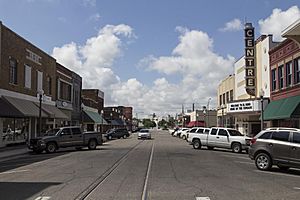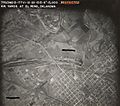El Reno, Oklahoma facts for kids
Quick facts for kids
El Reno
|
|
|---|---|
|
City
|
|

Downtown El Reno
|
|
| Country | United States |
| State | Oklahoma |
| County | Canadian |
| Area | |
| • Total | 80.18 sq mi (207.66 km2) |
| • Land | 79.58 sq mi (206.12 km2) |
| • Water | 0.59 sq mi (1.54 km2) |
| Elevation | 1,339 ft (408 m) |
| Population
(2020)
|
|
| • Total | 16,989 |
| • Density | 213.47/sq mi (82.42/km2) |
| Time zone | UTC-6 (Central (CST)) |
| • Summer (DST) | UTC-5 (CDT) |
| ZIP code |
73036
|
| Area code(s) | 405 |
| FIPS code | 40-23700 |
| GNIS feature ID | 2410416 |
| Website | https://www.elrenook.gov |
El Reno is a city in Oklahoma, United States. It is the main city of Canadian County. In 2020, about 16,989 people lived there.
The city started soon after the 1889 land rush. It was named after a nearby army base called Fort Reno. El Reno is in Central Oklahoma, about 25 miles (40 km) west of Oklahoma City.
Contents
History
How El Reno Got Its Name
The land where El Reno is now used to belong to the Cheyenne and Arapaho tribes. In 1874, the United States built a fort there. General Philip Sheridan was in charge and named it Fort Reno. He named it to honor his friend, General Jesse L. Reno, who died in the American Civil War.
After the 1889 land rush, there were three places with "Reno" in their name: Fort Reno, Reno City, and the village of El Reno. The village of El Reno started shortly after the land rush. Its post office opened in June 1889.
Even though "el reno" means "the reindeer" in Spanish, the town was not named after reindeer. Reindeer do not live in Oklahoma. The town's name came from Fort Reno. The word "el" (meaning "the" in Spanish) was added by the local postmaster. This helped people tell the difference between El Reno and the new Reno City.
Reno City was located north of the Canadian River. El Reno was on the south side. When the railroad decided to build its tracks on the south side of the river, Reno City moved to El Reno. The old Reno City site was left empty. Today, only Fort Reno and the city of El Reno remain.
Growth and Development
The first part of El Reno was planned on 120 acres of land owned by John Foreman. In 1890, his land and 80 acres from Thomas Jensen became part of the village of El Reno.
El Reno is located on the 98th meridian west. This is about 25 miles (40 km) west of Oklahoma City. The land east of this line was opened for settlement in the Land Rush of 1889. The land to the west was opened in 1892. This was when some Cheyenne and Arapaho lands became available. El Reno was chosen as the office for the 1901 land lottery drawings.
Federal Prison
In 1932, the United States Southwestern Reformatory was built near El Reno. It was a prison for young adult male prisoners. In the 1970s, it was renamed the Federal Correctional Institution, El Reno (FCI El Reno). Now, men of all ages are held there. It is a medium-security prison and one of the largest federal prisons in the U.S. The prison is also one of the biggest employers in El Reno. In 2015, President Barack Obama visited the prison. This was the first time a sitting president had visited a federal prison.
Fort Reno During World War II
During World War II, Fort Reno was used as a prisoner of war camp. It held German and Italian prisoners. There is a cemetery there with stones for the prisoners who died.
After World War II, the U.S. Army no longer needed the fort. In 1948, it was given to the U.S. Department of Agriculture. It is now a research laboratory. Scientists there study how to grow plants and raise animals in a way that helps the environment. This helps protect the Great Plains of North America.
Railroad History
Railroads used to be very important to El Reno's economy. The Chicago, Rock Island and Pacific Railroad (often called "Rock Island") had a large repair center and train station here. Many people worked for the railroad in El Reno. However, the railroad went out of business in 1979. It closed its station and train yards in 1980. The train yards are still empty today.
Culture
Fried Onion Burgers
A local story says that the fried onion burger was created in El Reno in the 1920s. The owner of the Hamburger Inn wanted to save money. He used less meat in his five-cent burgers by adding fried onions.
Since 1988, El Reno has an annual Fried Onion Burger Day Festival. It takes place downtown on the first Saturday in May.
Streetcar Service
In 2001, El Reno was the first city in Oklahoma to bring back streetcar service downtown. This service had stopped in 1947. The Heritage Express Trolley was the only operating trolley line in Oklahoma that year. Another line has since started in Oklahoma City. The Heritage Express was built with help from a federal grant. It was also part of a plan to improve downtown streets.
Historical Preservation
The old train depot and other buildings are now part of a museum complex. The Canadian County Historical Society uses them for this purpose. The 1954 film Human Desire has scenes filmed in the El Reno train yards.
El Reno is a "Main Street America" community. This program helps improve downtown areas. El Reno started its program in 1988. In 2006, it won the Great American Main Street Award. El Reno's program focuses on the Rock District downtown.
Several buildings in El Reno are on the National Register of Historic Places. These include the Carnegie Library, El Reno High School, and the Mennoville Mennonite Church.
Geography
El Reno has a total area of about 80.4 square miles (208.2 km2). Most of this is land, with a small amount of water.
El Reno is located where I-40 and U.S. Route 81 meet. It used to be on the border between Oklahoma Territory and Indian Territory. It is about 20 miles (32 km) west of the old Chisholm Trail. Jesse Chisholm is buried nearby.
Climate and Weather Events
El Reno has experienced many strong weather events, especially tornadoes.
On May 24, 2011, a very powerful tornado hit parts of northwestern El Reno. This tornado was an EF5 tornado. It caused 9 deaths and injured 181 people. Its winds were measured at almost 295 miles per hour (475 km/h).
Two years later, on May 31, 2013, a record-breaking tornado hit rural areas near El Reno. This tornado was the widest ever recorded, at 2.6 miles (4.2 km) wide. Sadly, several storm chasers, including Tim Samaras and his team, died in this tornado.
An EF3 tornado hit southern El Reno on May 25, 2019. It touched down at 10:32 pm. The tornado damaged a gas station and crossed Interstate 40. It then hit a motel and a mobile home park, causing a lot of damage. Two people died, and 19 were injured. The tornado also damaged other buildings and trees before it ended.
| Climate data for El Reno, Oklahoma | |||||||||||||
|---|---|---|---|---|---|---|---|---|---|---|---|---|---|
| Month | Jan | Feb | Mar | Apr | May | Jun | Jul | Aug | Sep | Oct | Nov | Dec | Year |
| Mean daily maximum °F (°C) | 47.4 (8.6) |
53.0 (11.7) |
63.2 (17.3) |
73.4 (23.0) |
80.8 (27.1) |
88.7 (31.5) |
94.4 (34.7) |
93.3 (34.1) |
84.8 (29.3) |
74.6 (23.7) |
60.4 (15.8) |
50.1 (10.1) |
72.0 (22.2) |
| Mean daily minimum °F (°C) | 23.9 (−4.5) |
28.6 (−1.9) |
37.3 (2.9) |
47.8 (8.8) |
56.6 (13.7) |
65.2 (18.4) |
70.1 (21.2) |
68.4 (20.2) |
60.7 (15.9) |
49.5 (9.7) |
37.3 (2.9) |
27.4 (−2.6) |
47.7 (8.7) |
| Average precipitation inches (mm) | 1.0 (25) |
1.3 (33) |
2.3 (58) |
2.6 (66) |
5.4 (140) |
4.4 (110) |
2.3 (58) |
2.8 (71) |
4.1 (100) |
2.5 (64) |
1.8 (46) |
1.0 (25) |
31.5 (800) |
| Source 1: weather.com | |||||||||||||
| Source 2: Weatherbase.com | |||||||||||||
Demographics
| Historical population | |||
|---|---|---|---|
| Census | Pop. | %± | |
| 1890 | 285 | — | |
| 1900 | 3,383 | 1,087.0% | |
| 1910 | 7,872 | 132.7% | |
| 1920 | 7,737 | −1.7% | |
| 1930 | 9,384 | 21.3% | |
| 1940 | 10,078 | 7.4% | |
| 1950 | 10,991 | 9.1% | |
| 1960 | 11,015 | 0.2% | |
| 1970 | 14,510 | 31.7% | |
| 1980 | 15,486 | 6.7% | |
| 1990 | 15,414 | −0.5% | |
| 2000 | 16,212 | 5.2% | |
| 2010 | 16,749 | 3.3% | |
| 2020 | 16,989 | 1.4% | |
| U.S. Decennial Census | |||
El Reno is part of the larger Oklahoma City Metropolitan Statistical Area.
In 2010, there were 16,749 people living in El Reno. There were 5,727 households and 3,842 families. About 71.8% of the people were White, 11.1% were Native American, and 7.2% were African American. About 12.9% of the population was Hispanic or Latino.
About 24.2% of the people were under 18 years old. The average age was 35 years.
Transportation
The Union Pacific railroad calls El Reno a "Train Town USA." This is because of the town's long history with the railroad.
Education
- Canadian Valley Technology Center is located on the famous Route 66, about 3 miles (4.8 km) east of the city.
- Redlands Community College opened in 1971.
Public schools that serve parts of El Reno include:
- El Reno Public Schools
- Banner Public School
- Darlington Public School
- Maple Public School
- Riverside Public School
Media
The El Reno Tribune is a local newspaper. It is published on Wednesdays and Sundays and has about 5,000 copies printed.
In Film
Several movies have been filmed partly in El Reno:
- Human Desire (1954), a film by Fritz Lang
- Rain Man (1988), starring Dustin Hoffman and Tom Cruise
- Elizabethtown (2005), a film by Cameron Crowe
- Parts of the film American Underdog were filmed here.
- Stillwater (2021), starring Matt Damon
- 13 Minutes (2021), a disaster film
- Twisters (2024), another disaster film
For many years, filmmaker George Kuchar would visit El Reno to film the storm season. He stayed at the El Reno Motel, and this led to his film Wild Night in El Reno.
Notable People
- Harlond Clift (1912–1992), a professional baseball player.
- Suzan Shown Harjo (1945-), an advocate for American Indian rights.
- Solomon Andrew Layton (1864–1943), an architect who lived in El Reno.
- Sam Pittman (1961-), Head Football Coach for the Arkansas Razorbacks.
- Harvey Pratt (1941-), a Native American forensic artist.
- Hub Reed (1936-), a professional basketball player.
- Erik Rhodes (1906–1990), a Broadway and Hollywood actor.
- Sam Rivers (1923–2011), a jazz musician and composer.
- Kenzie Ruston (1991-), a NASCAR driver.
- Gaylord Shaw (1942-), a journalist who won a 1978 Pulitzer Prize.
- Robert Stanley (aviator) (1912–1977), a test pilot.
Images for kids
See also
 In Spanish: El Reno (Oklahoma) para niños
In Spanish: El Reno (Oklahoma) para niños





